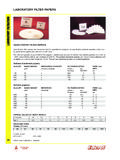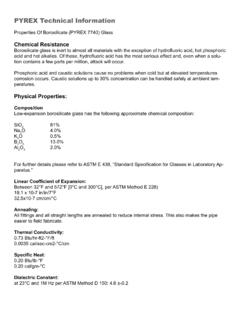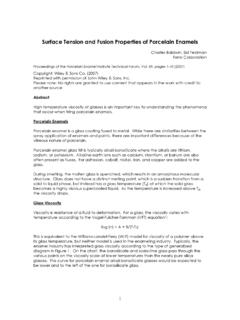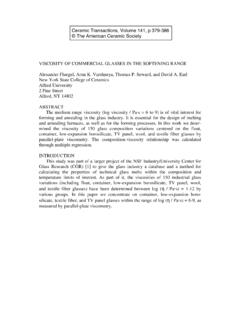Transcription of Laboratory Glassware - Scharlab Magyarország
1 Laboratory Glasswaren edition No. 2 nIndexIntroduction 3 Ground joint Glassware 13 Volumetric Glassware 53 General Laboratory Glassware 65 Alphabetical index 76 ndice alfab tico 77 Reference index +34 93 715 67 253 Scharlab The Lab Sourcing GroupScharlau glasswareUntil now Scharlab had limited its sales to the Spanish market. However, now, coinciding with the inauguration of the new workshop next to our warehouse in Sentmenat, we are ready to export our scientific Glassware to other and made to orderProducts for which there is regular demand are produced in larger quantities and then stocked for almost immediate supply. Other products are either manufactured directly from glass tubing or are constructed from a number of semi-finished today, scientific glassblowing remains a highly skilled hand craft and the quality of Glassware depends on the skill of each blower.
2 Careful selection of the raw glass ensures that our final products are free from imperfections such as air lines, scratches and stones. You will be able to judge for yourself the workmanship of our Glassware our Glassware is annealed and made stress free to avoid has been in the scientific Glassware business for over 15 : +34 93 745 64 00 Scharlab The Lab Sourcing Group4 GlasswareGlasswareScharlau Glassware is made from borosilicate glass that meets the specifications of the following standards: BS ISO 3585, DIN 12217 Type borosilicate glass ASTM E-438 Type 1 Class A borosilicate glass US Pharmacopoeia Type 1 borosilicate glass European Pharmacopoeia Type 1 GlassThe typical chemical composition of our borosilicate glass is as follows.
3 SiO2 81% B2O3 13% Na2O 4% Al2O3 2% glass is an inorganic substance that on cooling becomes rigid without crystallising and therefore it has no melting point as are 4 temperatures worth noting: The working pointThe temperature at which glass reaches a viscosity of 104 poise. At this temperature glass is soft enough for most lamp-working or sealing tasks. borosilicate reaches this state at 1252 C.
4 The softening pointThe temperature at which glass reaches a viscosity of 107. 6 poise. borosilicate reaches this state at 821 C. The annealing pointThe temperature at which the internal stress caused by rapid cooling (within 15min) from Working Point temperatures is safely relieved. borosilicate reaches this state at 565 C. The strain pointThe temperature at which the internal stress in a glass is substantially relieved only after several hours. borosilicate reaches this state at 510 resistanceBorosilicate glass is resistant to attack from water, acids, halogens and organic solvents. It has moderate resistance to alkaline solutions and is not resistant to hydrofluoric acid, hot concentrated phosphoric acid nor strong alkaline +34 93 715 67 255 Scharlab The Lab Sourcing GroupSafe handling of glasswareSafe handling of Glassware Wear protective clothing such as cut resistant gloves, eye protection, aprons, lab coats when manipulating and working with Laboratory Glassware Do not use chipped or broken Glassware as you may get cut.
5 Such Glassware also breaks more easily. Use safety shields, nets or coatings to prevent broken glass from hitting you. Check all Glassware for damage as even small cracks, chips or scratches affect the strength of the Glassware . Never heat damaged Glassware as resistance to heat is equally compromised. Use wire gauze when heating with an open flame or use only up to a medium heat when using a hot plate. Heat up and cool down Glassware as slowly as possible even when using borosilicate glass which has a very low coefficient of expansion. Maximum working temperature for borosilicate glass is 500 C however special precautions must be employed even when working above 150 C.
6 Do not heat extra thick Glassware . This Glassware is ideal for working under vacuum when higher mechanical strength is required, but this glass is less heat resistant. Do not subject ordinary, thin walled, Laboratory Glassware to pressure or vacuum. Lift Glassware by the body and not by the more fragile rims or side arms. When heating glass bottles, loosen the caps. Be careful when sliding tubing over sidearms. Always use protective gloves. Never pipette by mouth. You may get intoxicated, burn your mouth or cut your lip. Do not use excessive force and wear protective gloves when trying to free stuck jointed Glassware . Use only gentle tapping or rocking of the two sides of the joints.
7 The use of threaded safety joints prevents joints from getting stuck. Do not leave pipettes or glass -rods sticking out of beakers, bottles or flasks. Do not heat Glassware to over 420 C. This will cause stresses in the Glassware that will eventually cause it to : +34 93 745 64 00 Scharlab The Lab Sourcing Group6 Cleaning of Glassware Care and handling of glasswareCleaning of Glassware GeneralThe cleaning procedure for Glassware depends on the type of material contained in glass has excellent resistance to most acids except hydrofluoric acid. Strong alkaline solutions will also attack the glass , which is why detergents should be diluted up to no more than 2% strength.
8 Avoid exposure to detergents for long periods and avoid the same drying on the glass . Glassware should be cleaned as soon as possible to prevent the residues from hardening. I deally give Glassware a rinse or soak with organic solvent to remove grease and then another thorough rinse with water. Cleaning can be done in a glass washing machine or manually. Washing machineChoose from the wide variety of detergent formulations offered by Laboratory specialists for washing machines, depending on the residues you need to eliminate. These formulations are optimised for typical Laboratory that the support racks and pins are well coated with a nonabrasive material to prevent the glass from being scratched or broken by a hard surface.
9 Manual washUse only soft sponges or other soft clothes or plastic core brushes with non-abrasive from the wide variety of detergent formulations offered by Laboratory specialists for manual washing, depending on the residues you need to eliminate. These formulations are optimised for typical Laboratory residues. Specialised cleaning methods1. Permanganate stains. Use a mixture of equal volume 3% sulphuric acid and 3% hydrogen Iron stains. Use a solution containing equal parts of hydrochloric acid and Bacteriological material. Glassware should be soaked in a disinfectant solution or steam autoclaved. After that clean with a detergent. Special precautions during the cleaning process: Do not use any abrasive sponges as used in kitchens for cleaning pots.
10 Avoid any detergents or cleaning solutions that contain abrasive particles. Remove any hard objects like metal spatulas, stirring rods or brushes immediately. They can break the glass or scratch it. Strong alkaline domestic or industrial detergents will dissolve the glass and eventually cause breakage. Remove any kind of metal jewellery as well as rings with stones if you plan to introduce your hand inside +34 93 715 67 257 Scharlab The Lab Sourcing GroupVolumetric Glassware Ground- glass joints and glass stopcocksVolumetric Glassware Volumetric Glassware requires additional precautions during cleaning and handling: With volumetric Glassware one has to ensure reproducibility.




